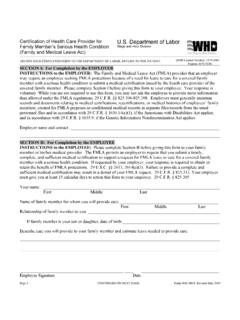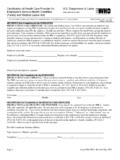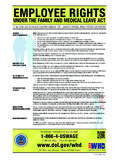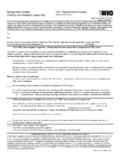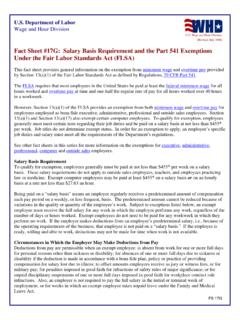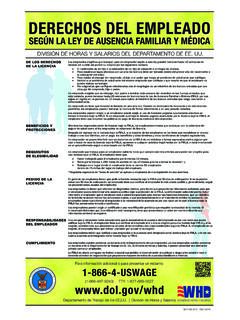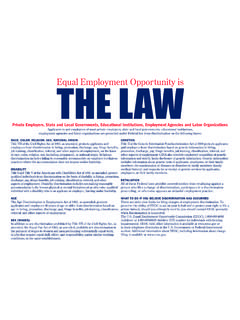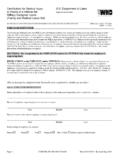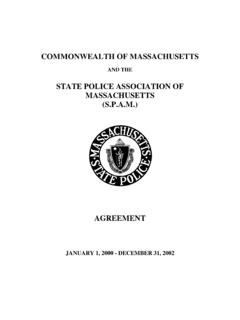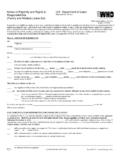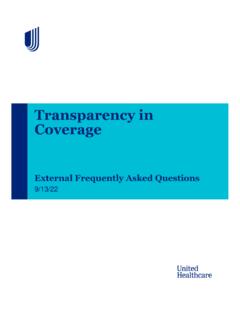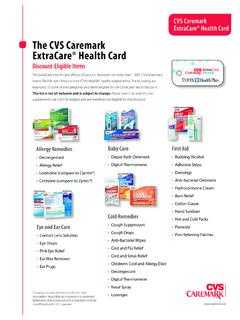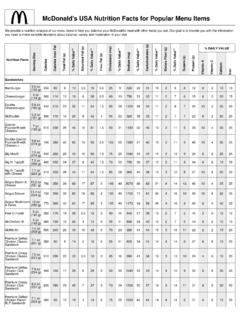Transcription of FAQs about Affordable Care Act and Consolidated …
1 FAQS about Affordable CARE ACT AND Consolidated APPROPRIATIONS ACT, 2021 IMPLEMENTATION PART 49 August 20, 2021 Set out below are Frequently Asked Questions (FAQs) regarding implementation of certain provisions of the Affordable Care Act (ACA) and certain provisions of title I (the No Surprises Act) and title II (Transparency) of Division BB of the Consolidated Appropriations Act, 2021 (the CAA). These FAQs have been prepared jointly by the Departments of Labor, health and Human Services (HHS), and the Treasury (collectively, the Departments). Like previously issued FAQs (available at and ), these FAQs answer questions from stakeholders to help people understand the law and promote compliance. Transparency in Coverage Machine-Readable Files The Transparency in Coverage Final Rules (the TiC Final Rules) require non-grandfathered group health plans and health insurance issuers offering non-grandfathered coverage in the group and individual markets to disclose on a public website information regarding in-network provider rates for covered items and services, out-of-network allowed amounts and billed charges for covered items and services, and negotiated rates and historical net prices for covered prescription drugs in three separate machine-readable The machine-readable file requirements of the TiC Final Rules are applicable for plan years (in the individual market, policy years) beginning on or after January 1, 2022.
2 Q1: Will the Departments enforce the machine-readable file provisions in the TiC Final Rules? Yes, subject to two exceptions, plans and issuers must make public machine-readable files disclosing in-network rates and out-of-network allowed amounts and billed charges. Under the first exception, as an exercise of enforcement discretion, the Departments will defer enforcement of the TiC Final Rules requirement that plans and issuers publish machine-readable files relating to prescription drug pricing pending further rulemaking, as described Under the second exception, as an exercise of enforcement discretion, the Department will defer enforcement of the TiC Final Rules requirement to publish the remaining machine-readable files until July 1, 2022, as described in Q2.
3 After the Departments finalized the TiC Final Rules, Congress enacted the CAA, which imposes important new transparency requirements on plans and issuers, including prescription drug reporting requirements under section 204 of division BB of the CAA. These requirements 1 85 FR 72158 (Nov. 12, 2020). 2 26 CFR (b)(1)(iii), 29 CFR (b)(1)(iii), and 45 CFR (b)(1)(iii). 1 significantly changed the regulatory landscape since the TiC Final Rules were adopted. Moreover, stakeholders have expressed concern about potentially duplicative and overlapping reporting requirements for prescription drugs. For example, under the TiC Final Rule, plans and issuers must publicly post pricing information for all covered prescription drugs by January 1, 2022.
4 Under section 204 of the No Surprises Act, however, plans and issuers must also report some of the same prescription drug pricing information to the Departments by December 27, 2021. In response to the later statutory enactment and stakeholder concerns, as an exercise of enforcement discretion, the Departments will defer enforcement of the requirement in the TiC Final Rules that plans and issuers must publish machine-readable file related to prescription drugs while it considers, through notice-and-comment rulemaking, whether the prescription drug machine-readable file requirement remains appropriate. HHS encourages states that are primary enforcers of this requirement with regard to issuers to take a similar enforcement approach and will not determine that a state is failing to substantially enforce this requirement if it takes such an approach.
5 Q2: Are plans and issuers required to make public the machine-readable files for in-network rates and out-of-network allowed amounts and billed charges for plan years (in the individual market, policy years) beginning on or after January 1, 2022? The Departments recognize the number of CAA provisions plans and issuers are required to implement by January 1, 2022 and the considerable time and effort required to make the machine-readable files available in the form and manner required in the TiC Final Rules at the same Therefore, with respect to plan or policy years beginning on or after January 1, 2022, as an exercise of enforcement discretion, the Departments will defer enforcement of the requirement to make public the machine-readable files for in-network rates and out-of-network allowed amounts and billed charges, until July 1, 2022.
6 On July 1, 2022, the Departments intend to begin enforcing the requirement that plans and issuers publicly disclose information related to in-network rates and out-of-network allowed amounts and billed charges for plan years (in the individual market, policy years) beginning on or after January 1, 2022. For 2022 plan years and policy years beginning subsequent to July 1, 2022, plans and issuers should thus post the machine-readable files in the month in which the plan year (in the individual market, policy year) begins, consistent with the applicability provision of the TiC Final Rules. HHS encourages states that are primary enforcers of this requirement with regard to issuers to take a similar enforcement approach and will not determine that a state is failing to substantially enforce this requirement if it takes such an approach.
7 Price Comparison Tools The TiC Final Rules require plans and issuers to make price comparison information available to participants, beneficiaries, and enrollees through an internet-based self-service tool and in paper 3 26 CFR , 29 CFR , and 45 CFR 2 form, upon This information must be available for plan years (in the individual market, policy years) beginning on or after January 1, 2023, with respect to the 500 items and services identified by the Departments in Table 1 in the preamble to the TiC Final Rules,5 and with respect to all covered items and services, for plan or policy years beginning on or after January 1, Internal Revenue Code (Code) section 9819, Employee Retirement Income Security Act (ERISA) section 719, and Public health Service (PHS) Act section 2799A-4, as added by section 114 of division BB of the CAA, require plans and issuers to offer price comparison guidance by telephone and make available on the plan s or issuer s website a price comparison tool that (to the extent practicable)
8 Allows an individual enrolled under such plan or coverage, with respect to such plan year, such geographic region, and participating providers with respect to such plan or coverage, to compare the amount of cost-sharing that the individual would be responsible for paying under such plan or coverage with respect to the furnishing of a specific item or service by any such provider. This requirement is applicable with respect to plan years (in the individual market, policy years) beginning on or after January 1, 2022. Q3: How do the different regulatory and statutory requirements for the self-service price comparison tools under the TiC Final Rules and the CAA interact? The TiC Final Rules created a comprehensive set of requirements for plan and issuer disclosure of estimated cost-sharing information through an online tool, and in paper form, upon request.
9 These requirements for the disclosure of cost-sharing information would allow a participant, beneficiary, or enrollee to request cost-sharing information for a discrete covered item or service by billing code or descriptive term, according to the participant s, beneficiary s, or enrollee s request. Further, the TiC Final Rules require a plan or issuer to provide cost-sharing information for a covered item or service in connection with an in-network provider or providers, or an out-of-network allowed amount for a covered item or service provided by an out-of-network provider, according to the participant s, beneficiary s, or enrollee s request, permitting the individual to specify the information necessary for the plan or issuer to provide meaningful cost-sharing liability information.
10 Because the price comparison methods required by the CAA are largely duplicative of the internet-based self-service tool component of the TiC Final Rules, the Departments intend to propose rulemaking and seek public comment regarding, among other issues, whether compliance with the internet-based self-service tool requirements of the TiC Final Rules satisfies the analogous requirements set forth in Code section 9819, ERISA section 719, and PHS Act section 2799A-4. These provisions, however, add a requirement that was not imposed under the TiC Final Rules: that price information also must be provided over the telephone upon request. Therefore, the Departments intend to propose rulemaking requiring that the same pricing information that is available through the online tool or in paper form, as described in the TiC Final Rules, must also be provided over the telephone upon request.
